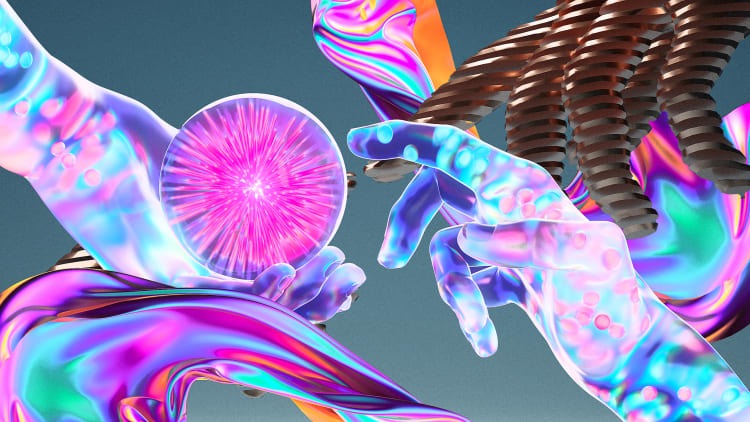- | 9:00 am
Why the future of product design is all about how it feels
After nearly two decades of sleek minimalism in digital interactions, tactile design is emerging to use texture and materiality to bring back the lost art of touch.

In 2007, Apple won the smartphone wars by betting on our collective desire to fall into the iPhone’s looking-glass screen and explore the digital wonderland that waited for us on the other side. We’ve spent the intervening years building the cyberfrontier with a rampant fervor—designing innumerable digital products and experiences. But recently, we’ve started recognizing something was lost in the wake of sleek, digital minimalism.
Touch is our most complex sensory system by far. It is an essential part of processing our surroundings—but an overemphasis on digital experiences has led to a homogenized design language that flattens our ways of interacting with the world around us.
Enter tactile design
Tactile design is a return to tangibility. It is an emerging approach to design that prioritizes elements like material, texture, and weight. It builds upon established visual and auditory design systems to create a more immersive, intuitive, and multisensory experience.
When we over-prioritize our visual experience, we divorce ourselves from a rich trove of physical sensory information our brains so desperately crave. A Connected Consumer Survey by Deloitte found that 44% of consumers ages 18-40 feel that their device usage may negatively impact their connection to the physical world—and research indicates that products with tactile elements can “reinforce memories and deepen experiences” for users.
It’s no coincidence that we’ve seen a rise in analog experiences, from typewriters to flip phones to CDs and vinyl. Interacting with physical products—touching the material, hearing the clicking of keys, feeling the weight—allows users to form a unique relationship and ritual with their objects. Tactility has long been a hallmark of luxury goods from fashion to furniture—evoking craftsmanship and reminding us of the care put into a product’s design. Whether handmade or machined, this connection to materiality increases the object’s perceived value and emotional resonance—and we can feel it; the best products engage all our senses, and our whole being is instinctively tuned in.
Several brands are already emphasizing tactility to create memorable, multisensory experiences. At this year’s London Design Festival, Dezeen and ASUS Zenbook organized an exhibition called Design You Can Feel, which challenged six design studios to explore how form, color, and texture combine to engage the senses. Gentle Monster has been developing a “future of retail” concept called Haus Dosan, in which different floors create experiences tailored to a specific sense. And Google’s Little Signals created physical objects that used motion, sound, and subtle visual cues to help users stay up-to-date with reminders and tasks without having to interact with a screen.
Design plus accessibility
Alongside the aesthetic and experiential appeal, tactile design enhances the usability and accessibility of products we interact with. Customer complaints about the safety of touchscreens in cars have prompted automakers like Kia and Volkswagen to reintroduce buttons and knobs for critical functions, and the European New Car Assessment Program plans to introduce new standards for physical buttons in 2026 for cars looking to earn a five-star safety rating.
Cars aren’t the only ones bringing back buttons; Apple has introduced action and camera control buttons to provide easier access to routine actions. Physical buttons enable users to rely on muscle memory for quicker, more intuitive interactions in environments where touchscreens could be distracting or less practical to navigate and provide an alternative to capacitive screens that hinder accessibility for older people and those with disabilities.
A return to tangible interactions
Tactile design isn’t just a passing trend; it points to a more significant transformation within product design that requires brands to consider a multisensory experience across user touchpoints. Tactile design isn’t without its challenges, chief among them being the time and effort needed to launch working physical features. However, these challenges aren’t exclusive to developing tactile features; consumers have become weary of companies overpromising and under-delivering digital features in beta product releases. When brands take the time to design physical and digital features, the benefits can far outweigh the drawbacks—improved usability, increased consumer trust, and deeper emotional connection, to name a few.
Tactile design provides a much-needed return to tangible interactions that engage our senses beyond the flat visual and auditory experiences that have become the norm over the past 15+ years. Designers have a chance to create products that not only function well but can also last longer by fostering deeper emotional connections with users.
In a world dominated by screens, consumers seek products that use materiality and physical interactions to help us have a more meaningful, accessible, and embodied relationship with technology. As we design for the future, let’s prioritize experiences that play with our senses and ensure that our products aren’t just used but valued and enjoyed for years to come.
Dan Harden is CEO and principal designer at Whipsaw.





































